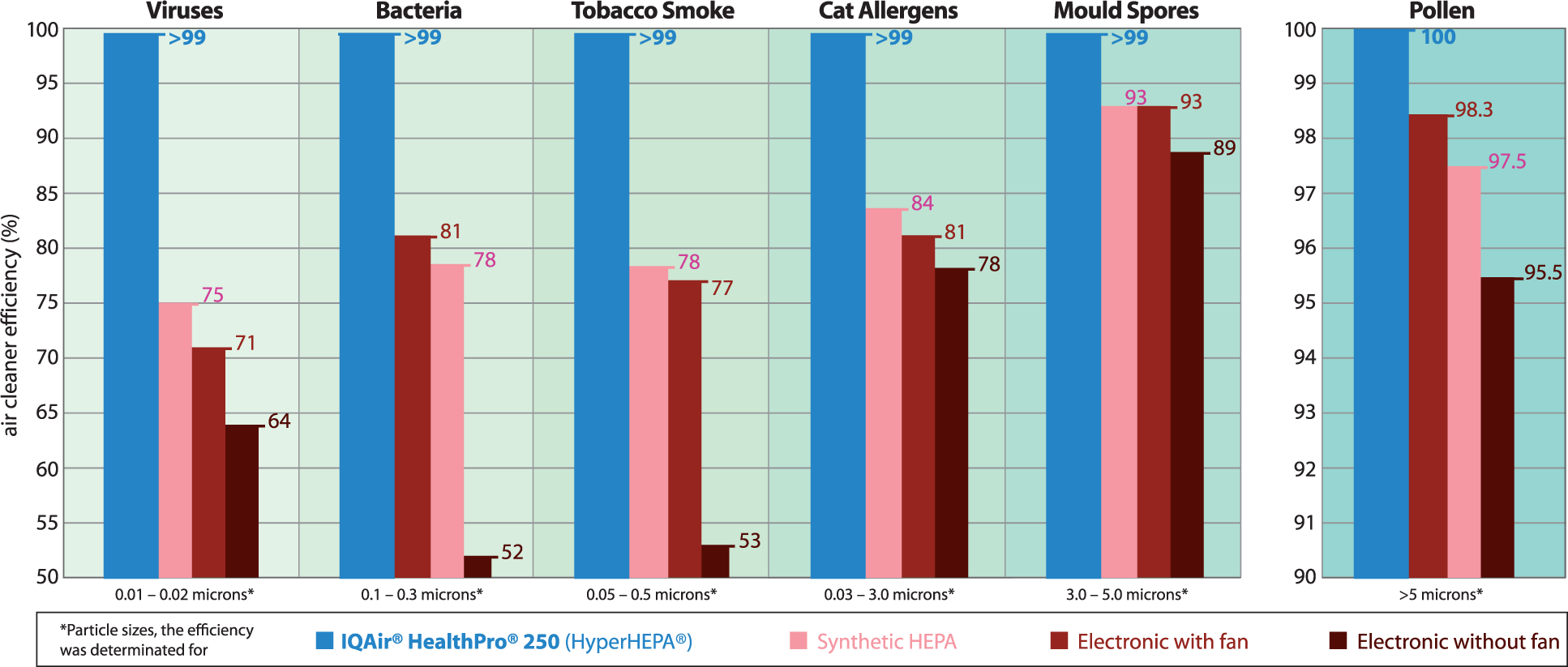Independent Laboratory had guaranteed the IQAir Results...
HEPA air purifiers are top of the line and used by allergy and asthma doctors to alleviate the harsh symptoms of these conditions. Discover the best HEPA air purifiers that use HEPA technology to address Asthma and Allergy symptoms.
History of HEPA Air Purifier Technology
In the 1950s, the US Atomic Energy Commission needed something to remove small radioactive particulates, so High Efficiency Particulate Arresting (HEPA) filters were developed. Since then, HEPA filtration has been used in air purifiers to clean the indoors in spaces like medical cleanrooms and beauty salons. HEPA products are also part of treatments used by doctors to help alleviate allergy and asthma symptoms.
IQAir's HyperHEPA Technology

The accredited test laboratory Interbasic Resources, Inc. purchased a number of room air cleaners on the open market and tested them for their filtration efficiency. Only the IQAir HealthPro 250 was able to trap over 99% of virtually all types of pollution particles. Since the IQAir HealthPro 100 and HealthPro 150 models feature identical particle filters to the HealthPro 250, the same results can also be expected of these models. The below graphs are based on independent laboratory tests which determined the HyperHEPA filter's removal efficiency for various particle size ranges.
What is a HEPA air purifier?
HEPA air purifiers are top of the line and used by allergy and asthma doctors to alleviate the harsh symptoms of these conditions. Imagine a filter that only allows very tiny particles to pass through. If we place a single sheet of this HEPA material in front of a fan, constrained as it would be in air purifiers, very little air would be able to pass because of the small size of the holes.
Due to the high performance of HEPA air purifiers, the filter will need to be changed often, as the small holes rapidly catch particles. Doubling the size of the HEPA filter sheet would allow twice the airflow and filter life. Moreover, folding the sheet back and forth in a zig-zag formation will then present a very large surface area for airflow; this design is how HEPA air purifiers are so efficient and effective. Authentic HEPA filters and HEPA air purifiers may require as much as 40 square feet of the HEPA filter material. HEPA material is typically constructed as fiber, paper-like, or polymer.
HEPA material looks like a very thin bail of fibers. Air has to find a route through this maze of fibers, and there are three steps in the HEPA filter process of trapping particulates. First, a particle runs into the fiber and sticks. Then, the particle gets within one diameter of a fiber in the HEPA air purifier; while it tries to get by the fiber it becomes stuck to the fiber. Finally, as a very small particle (about 0.1 micron) moves in the gas flow, it dithers about due to collisions with molecules (Brownian motion); the particle slides close to the fiber and becomes caught. This is how HEPA air purifiers stop mold spores, as well as many bacteria, viruses, and dust.
Top performing HEPA air purifiers, like the Alen A350 air purifier, remove at least 98% of particles (0.3 microns and larger). However, pure HEPA air purifiers do not remove odors, chemicals, or gases, unless combatting them specifically with add-on technologies. These are molecular level substances, and the holes of the HEPA material are large compared to the gas molecules, allowing them to pass through. Advanced HEPA air purifiers are engineered to target odors by using activated carbon to absorb odors and chemicals as the air passes through the air purifier.
Activated carbon levels will vary depending upon the unit. The substantial amount of activated carbon in a HEPA AllerAir air purifier, for example, allows it to effectively capture chemicals, gases, and odors. The carbon absorbs gases that will not be caught by the HEPA air purifier alone. Alen and Blueair air purifiers are also brands that use activated carbon in combination with HEPA filtration to provide light odor coverage. We also offer heavy duty filters to remove odors, smoke, chemicals, and gases.
Alen and Blueair use an advanced approach to HEPA filtration that makes their air purifiers especially efficient. These air purifiers employ electrostaticity in the airflow prior to the HEPA element. This additional technology charges the pollution particles, causing them to stick to the filter media.
To recap, HEPA air purifiers force airflow through a filter. The more times the airflow passes through the filter in an hour, the cleaner the room. The larger the space, the more square footage capacity an air purifier will need. HVAC HEPA air filters are insufficient for cleaning the air in your entire home, let alone one room. It is important to consider a HEPA air purifier for every room for a whole house air quality solution.

